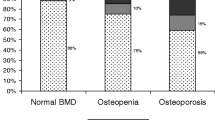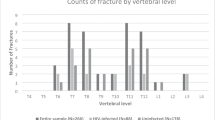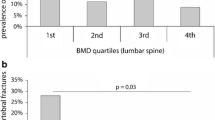Abstract
Summary
The prevalence of asymptomatic vertebral fracture in HIV-infected patients over 50 was 20%, associated with older age, male sex, longer time since HIV diagnosis, and tubular renal alterations. Vertebral fractures were independent of osteoporosis at lumbar spine, and were not predicted by the use of the FRAX equation.
Purpose
Vertebral fractures (VF) are the hallmark of osteoporotic fractures. Our objective was to determine the prevalence of asymptomatic VF and associated factors in HIV-infected patients over 50 years, and the role of FRAX equation.
Methods
In a cross-sectional study, a diagnosis of VF was established by the semiquantitative method of Genant in thoracic and lumbar radiographs. Simultaneously, a dual X-ray absorptiometry (DXA), bone and kidney-related analytical, calcium intake, physical exercise, HIV-related factors, and FRAX estimation were evaluated.
Results
Overall, 128 patients (35 women, 27%) were included. Mean age was 57 years. Hypophosphatemia and tubular renal dysfunction were observed in 13 and 21%. DXA scan showed osteopenia and osteoporosis at hip in 65 and 7% of patients, and in spine in 39 and 34%, respectively. VF were observed in 26 patients (20%), with a trend to be associated with lower serum phosphate, increased alkaline phosphatase, and with lower daily calcium intake. In a multivariate analysis, older age (OR 1.2 per year; 14% of VF at 50–55; 44% at 65–70), male sex (26 vs 6%), longer time since HIV diagnosis, and renal and tubular dysfunction were the associated factors. VF were not related with osteoporosis at lumbar spine, and could not be predicted by the FRAX equation.
Conclusions
The prevalence of asymptomatic vertebral fractures is high in HIV-infected patients older than 50 years, and is not identified by the presence of osteoporosis in spine neither predicted by the FRAX equation. Spine and lumbar X-rays should be routinely performed in this aging population.



Similar content being viewed by others
References
Arnsten JH, Freeman R, Howard AA, Floris-Moore M, Santoro N, Schoenbaum EE (2006) HIV infection and bone mineral density in middle-aged women. Clin Infect Dis Off Publ Infect Dis Soc Am 42(7):1014–1020
Porcelli T, Gotti D, Cristiano A, Maffezzoni F, Mazziotti G, Focà E, Castelli F, Giustina A, Quiros-Roldan E (2014) Role of bone mineral density in predicting morphometric vertebral fractures in patients with HIV infection. Osteoporos Int J Establ Result Coop Eur Found Osteoporos Natl Osteoporos Found USA 25(9):2263–2269
Amiel C, Ostertag A, Slama L, Baudoin C, N’Guyen T, Lajeunie E et al (2004) BMD is reduced in HIV-infected men irrespective of treatment. J Bone Miner Res Off J Am Soc Bone Miner Res 19(3):402–409
Brown TT, Qaqish RB (2006) Antiretroviral therapy and the prevalence of osteopenia and osteoporosis: a meta-analytic review. AIDS Lond Engl. 20(17):2165–2174
Walker Harris V, Brown TT (2012 Jun) Bone loss in the HIV-infected patient: evidence, clinical implications, and treatment strategies. J Infect Dis 205(Suppl 3):S391–S398
Casado JL, Bañon S, Andrés R, Perez-Elías MJ, Moreno A, Moreno S (2014) Prevalence of causes of secondary osteoporosis and contribution to lower bone mineral density in HIV-infected patients. Osteoporos Int J Establ Result Coop Eur Found Osteoporos Natl Osteoporos Found USA 25(3):1071–1079
Castronuovo D, Cacopardo B, Pinzone MR, Di Rosa M, Martellotta F, Schioppa O et al (2013) Bone disease in the setting of HIV infection: update and review of the literature. Eur Rev Med Pharmacol Sci 17(18):2413–2419
Torti C, Mazziotti G, Soldini PA, Focà E, Maroldi R, Gotti D, Carosi G, Giustina A (2012) High prevalence of radiological vertebral fractures in HIV-infected males. Endocrine 41(3):512–517
Borderi M, Calza L, Colangeli V, Vanino E, Viale P, Gibellini D, Re MC (2014) Prevalence of sub-clinical vertebral fractures in HIV-infected patients. New Microbiol 37(1):25–32
Gazzola L, Savoldi A, Bai F, Magenta A, Dziubak M, Pietrogrande L, Tagliabue L, del Sole A, Bini T, Marchetti G, d’Arminio Monforte A (2015) Assessment of radiological vertebral fractures in HIV-infected patients: clinical implications and predictive factors. HIV Med 16(9):563–571
Hansen A-BE, Gerstoft J, Kronborg G, Larsen CS, Pedersen C, Pedersen G, Obel N (2012) Incidence of low and high-energy fractures in persons with and without HIV infection: a Danish population-based cohort study. AIDS Lond Engl 26(3):285–293
Triant VA, Brown TT, Lee H, Grinspoon SK (2008) Fracture prevalence among human immunodeficiency virus (HIV)-infected versus non-HIV-infected patients in a large U.S. healthcare system. J Clin Endocrinol Metab 93(9):3499–3504
Womack JA, Goulet JL, Gibert C, Brandt C, Chang CC, Gulanski B, Fraenkel L, Mattocks K, Rimland D, Rodriguez-Barradas MC, Tate J, Yin MT, Justice AC, for the Veterans Aging Cohort Study Project Team (2011) Increased risk of fragility fractures among HIV infected compared to uninfected male veterans. PLoS One 6(2):e17217
Prieto-Alhambra D, Güerri-Fernández R, De Vries F, Lalmohamed A, Bazelier M, Starup-Linde J et al (2014) HIV infection and its association with an excess risk of clinical fractures: a nationwide case-control study. J Acquir Immune Defic Syndr 1999 66(1):90–95
Güerri-Fernandez R, Vestergaard P, Carbonell C, Knobel H, Avilés FF, Castro AS, Nogués X, Prieto-Alhambra D, Diez-Perez A (2013) HIV infection is strongly associated with hip fracture risk, independently of age, gender, and comorbidities: a population-based cohort study. J Bone Miner Res 28(6):1259–1263
Cauley JA, Hochberg MC, Lui L-Y, Palermo L, Ensrud KE, Hillier TA, Nevitt MC, Cummings SR (2007) Long-term risk of incident vertebral fractures. JAMA 298(23):2761–2767
Lindsay R, Silverman SL, Cooper C, Hanley DA, Barton I, Broy SB, Licata A, Benhamou L, Geusens P, Flowers K, Stracke H, Seeman E (2001) Risk of new vertebral fracture in the year following a fracture. JAMA 285(3):320–323
Melton LJ, Atkinson EJ, Cooper C, O’Fallon WM, Riggs BL (1999) Vertebral fractures predict subsequent fractures. Osteoporos Int J Establ Result Coop Eur Found Osteoporos Natl Osteoporos Found USA 10(3):214–221
Crans GG, Genant HK, Krege JH (2005) Prognostic utility of a semiquantitative spinal deformity index. Bone 37(2):175–179
Fink HA, Milavetz DL, Palermo L, Nevitt MC, Cauley JA, Genant HK, Black DM, Ensrud KE, Fracture Intervention Trial Research Group (2005) What proportion of incident radiographic vertebral deformities is clinically diagnosed and vice versa? J Bone Miner Res Off J Am Soc Bone Miner Res 20(7):1216–1222
Gehlbach SH, Bigelow C, Heimisdottir M, May S, Walker M, Kirkwood JR (2000) Recognition of vertebral fracture in a clinical setting. Osteoporos Int J Establ Result Coop Eur Found Osteoporos Natl Osteoporos Found USA 11(7):577–582
Ross PD (1997) Clinical consequences of vertebral fractures. Am J Med 103(2A):30S–42S discussion 42S–43S
Bañón S, Rosillo M, Gómez A, Pérez-Elias MJ, Moreno S, Casado JL (2015 Jun) Effect of a monthly dose of calcidiol in improving vitamin D deficiency and secondary hyperparathyroidism in HIV-infected patients. Endocrine 49(2):528–537
Mondy K, Yarasheski K, Powderly WG, Whyte M, Claxton S, DeMarco D, Hoffmann M, Tebas P (2003) Longitudinal evolution of bone mineral density and bone markers in human immunodeficiency virus-infected individuals. Clin Infect Dis Off Publ Infect Dis Soc Am 36(4):482–490
Institute of Medicine (US) Committee to Review Dietary Reference Intakes for Vitamin D and Calcium. Dietary reference Intakes for calcium and vitamin D [Internet]. Ross AC, Taylor CL, Yaktine AL, Del Valle HB, editors. Washington (DC): National Academies Press (US); 2011 [cited 2017 May 21]. (The National Academies Collection: Reports funded by National Institutes of Health). Available from: http://www.ncbi.nlm.nih.gov/books/NBK56070/
Craig CL, Marshall AL, Sjöström M, Bauman AE, Booth ML, Ainsworth BE et al (2003) International physical activity questionnaire: 12-country reliability and validity. Med Sci Sports Exerc 35(8):1381–1395
Del Palacio M, Romero S, Casado JL (2012) Proximal tubular renal dysfunction or damage in HIV-infected patients. AIDS Rev 14(3):179–187
Yin MT, Shiau S, Rimland D, Gibert CL, Bedimo RJ, Rodriguez-Barradas MC et al (2016) Fracture prediction with modified-FRAX in older HIV-infected and uninfected men. J Acquir Immune Defic Syndr 1999 72(5):513–520
Kidney Disease: Improving Global Outcomes (KDIGO) CKD-MBD Work Group (2009) KDIGO clinical practice guideline for the diagnosis, evaluation, prevention, and treatment of chronic kidney disease-mineral and bone disorder (CKD-MBD). Kidney Int Suppl (113):S1–S130
Kanis JA (2002) Diagnosis of osteoporosis and assessment of fracture risk. Lancet Lond Engl 359(9321):1929–1936
Genant HK, Wu CY, van Kuijk C, Nevitt MC (1993) Vertebral fracture assessment using a semiquantitative technique. J Bone Miner Res Off J Am Soc Bone Miner Res 8(9):1137–1148
Genant HK, Jergas M, Palermo L, Nevitt M, Valentin RS, Black D et al (1996) Comparison of semiquantitative visual and quantitative morphometric assessment of prevalent and incident vertebral fractures in osteoporosis: the Study of Osteoporotic Fractures Research Group. J Bone Miner Res Off J Am Soc Bone Miner Res 11(7):984–996
Kanis JA, Johnell O, Oden A, Johansson H, McCloskey E (2008) FRAX and the assessment of fracture probability in men and women from the UK. Osteoporos Int J Establ Result Coop Eur Found Osteoporos Natl Osteoporos Found USA 19(4):385–397
Martínez E, Jódar Gimeno E, Reyes García R, Carpintero P, Casado JL, Del Pino Montes J et al (2014) Consensus statement: recommendations for the management of metabolic bone disease in human immunodeficiency virus patients. Enferm Infecc Microbiol Clin 32(4):250–258
Sözen T, Özışık L, Başaran NÇ (2017) An overview and management of osteoporosis. Eur J Rheumatol 4(1):46–56
Greendale GA, Wilhalme H, Huang M-H, Cauley JA, Karlamangla AS (2016) Prevalent and incident vertebral deformities in midlife women: results from the Study of Women’s Health Across the Nation (SWAN). PLoS One 11(9):e0162664
Pitukcheewanont P, Safani D, Church J, Gilsanz V (2005) Bone measures in HIV-1 infected children and adolescents: disparity between quantitative computed tomography and dual-energy X-ray absorptiometry measurements. Osteoporos Int J Establ Result Coop Eur Found Osteoporos Natl Osteoporos Found USA 16(11):1393–1396
Yin MT, Lund E, Shah J, Zhang CA, Foca M, Neu N, Nishiyama KK, Zhou B, Guo XE, Nelson J, Bell DL, Shane E, Arpadi SM (2014) Lower peak bone mass and abnormal trabecular and cortical microarchitecture in young men infected with HIV early in life. AIDS Lond Engl 28(3):345–353
Sornay-Rendu E, Boutroy S, Munoz F, Delmas PD (2007) Alterations of cortical and trabecular architecture are associated with fractures in postmenopausal women, partially independent of decreased BMD measured by DXA: the OFELY study. J Bone Miner Res Off J Am Soc Bone Miner Res 22(3):425–433
Genant HK, Delmas PD, Chen P, Jiang Y, Eriksen EF, Dalsky GP, Marcus R, San Martin J (2007) Severity of vertebral fracture reflects deterioration of bone microarchitecture. Osteoporos Int J Establ Result Coop Eur Found Osteoporos Natl Osteoporos Found USA 18(1):69–76
Naves Díaz M (2006) Fracturas por osteoporosis en la mujer española. Med Clínica 127(11):413–414
Grados F, Marcelli C, Dargent-Molina P, Roux C, Vergnol JF, Meunier PJ, Fardellone P (2004) Prevalence of vertebral fractures in French women older than 75 years from the EPIDOS study. Bone 34(2):362–367
O’Neill TW, Felsenberg D, Varlow J, Cooper C, Kanis JA, Silman AJ (1996) The prevalence of vertebral deformity in European men and women: the European Vertebral Osteoporosis Study. J Bone Miner Res Off J Am Soc Bone Miner Res 11(7):1010–1018
Zeytinoglu M, Jain RK, Vokes TJ (2017) Vertebral fracture assessment: enhancing the diagnosis, prevention, and treatment of osteoporosis. Bone 104:54–65
Naylor KL, McArthur E, Leslie WD, Fraser L-A, Jamal SA, Cadarette SM, Pouget JG, Lok CE, Hodsman AB, Adachi JD, Garg AX (2014) The three-year incidence of fracture in chronic kidney disease. Kidney Int 86(4):810–818
Casado JL (2016) Renal and bone toxicity with the use of tenofovir: understanding at the end. AIDS Rev 18(2):59–68
Bedimo R, Rosenblatt L, Myers J (2016) Systematic review of renal and bone safety of the antiretroviral regimen efavirenz, emtricitabine, and tenofovir disoproxil fumarate in patients with HIV infection. HIV Clin Trials 17(6):246–266
Vannucci L, Masi L, Gronchi G, Fossi C, Carossino AM, Brandi ML (2017) Calcium intake, bone mineral density, and fragility fractures: evidence from an Italian outpatient population. Arch Osteoporos 12(1):40
Kanis JA, McCloskey EV, Johansson H, Cooper C, Rizzoli R, Reginster J-Y et al (2013) European guidance for the diagnosis and management of osteoporosis in postmenopausal women. Osteoporos Int J Establ Result Coop Eur Found Osteoporos Natl Osteoporos Found USA 24(1):23–57
Aberg JA, Gallant JE, Ghanem KG, Emmanuel P, Zingman BS, Horberg MA, Infectious Diseases Society of America (2014) Primary care guidelines for the management of persons infected with HIV: 2013 update by the HIV medicine association of the Infectious Diseases Society of America. Clin Infect Dis Off Publ Infect Dis Soc Am 58(1):e1–e34
Acknowledgements
We would like to thank Ana Abad for their important contribution in database management.
Author information
Authors and Affiliations
Contributions
JLC, MLL, and CM conceived and designed the study and were responsible for patient enrollment, follow-up, and data analysis and drafted and finalized the article; MR conceived and performed analytical evaluations, and WAS, SB, MJPE, MV, and SM were responsible for patient enrollment, clinically followed up patients, and helped to write the work. All coauthors revised the manuscript and approved the final version.
Corresponding author
Ethics declarations
Conflicts of interest
None.
Rights and permissions
About this article
Cite this article
Llop, M., Sifuentes, W.A., Bañón, S. et al. Increased prevalence of asymptomatic vertebral fractures in HIV-infected patients over 50 years of age. Arch Osteoporos 13, 56 (2018). https://doi.org/10.1007/s11657-018-0464-2
Received:
Accepted:
Published:
DOI: https://doi.org/10.1007/s11657-018-0464-2




